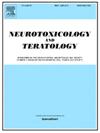母亲和产后早期抗生素暴露可能增加自闭症谱系障碍的风险
IF 2.8
3区 医学
Q3 NEUROSCIENCES
引用次数: 0
摘要
目的分析妊娠期及产后早期接触抗生素是否会增加自闭症谱系障碍伴回归(ASD-R)的风险。方法将483例ASD患儿分为ASD- r组和ASD无回归组(ASD- nr)。儿童护理人员填写了关于孕期和产后早期抗生素使用情况的问卷。结果ASD-R组孕妇妊娠期和2岁前抗生素暴露比例(10.3%和44.0%)显著高于ASD-NR组(2.9%和33.1%)。与没有接触过抗生素的儿童相比,有ASD和母亲接触过抗生素的儿童出现倒退的可能性更高(未经调整的OR = 3.81, 95% CI: 1.67-8.68;调整的OR = 3.36, 95% CI: 1.44-7.8)。此外,与未接触抗生素的儿童相比,在产后早期接触抗生素的自闭症儿童有更高的回归风险(未经调整的OR = 1.59, 95% CI 1.08-2.32;调整的OR = 1.50, 95% CI 1.01-2.21)。产妇和产后早期抗生素暴露与ABC的某些维度和总分有关。结论与ASD-NR组相比,ASD-R组在妊娠期和产后早期抗生素暴露率均较高。母亲和产后早期抗生素暴露可能是ASD儿童退化的危险因素。在孕期或产后早期接触过抗生素的自闭症儿童可能比没有接触过抗生素的儿童有更严重的核心症状。本文章由计算机程序翻译,如有差异,请以英文原文为准。
Maternal and early postnatal antibiotic exposure may increase the risk of autism spectrum disorder with regression
Purpose
To analyze if exposure to antibiotics during maternal pregnancy and early postnatal period increases the risk of autism spectrum disorder with regression (ASD-R).
Methods
A total of 483 children with ASD were categorized into ASD-R and ASD without regression (ASD-NR) groups. The caregivers of children completed questionnaires regarding use of antibiotics during maternal pregnancy and early postnatal period.
Results
There were significantly higher proportions of antibiotic exposure during maternal pregnancy and before age of 2 in the ASD-R group (10.3 % and 44.0 %) compared to the ASD-NR group (2.9 % and 33.1 %). Children with ASD and maternal antibiotic exposure had a higher likelihood of experiencing regression compared to those without exposure (unadjusted OR = 3.81, 95 %CI: 1.67–8.68; adjusted OR = 3.36, 95 %CI: 1.44–7.8). Also, children with ASD who were exposed to antibiotics during early postnatal period had a higher risk of regression, as opposed to those who were not exposed (unadjusted OR = 1.59, 95 % CI 1.08–2.32; adjusted OR = 1.50, 95 % CI 1.01–2.21). Both maternal and early postnatal antibiotic exposure were associated with certain dimensions and total scores of the ABC.
Conclusions
The ASD-R group had higher rates of antibiotic exposure during both maternal pregnancy and the early postnatal period compared to the ASD-NR group. Maternal and early postnatal antibiotic exposure may be risk factors for regression in children with ASD. Children with ASD who were exposed to antibiotics during maternal pregnancy or the early postnatal period may have more severe core symptoms than those without such history of exposure.
求助全文
通过发布文献求助,成功后即可免费获取论文全文。
去求助
来源期刊
CiteScore
5.60
自引率
10.30%
发文量
48
审稿时长
58 days
期刊介绍:
Neurotoxicology and Teratology provides a forum for publishing new information regarding the effects of chemical and physical agents on the developing, adult or aging nervous system. In this context, the fields of neurotoxicology and teratology include studies of agent-induced alterations of nervous system function, with a focus on behavioral outcomes and their underlying physiological and neurochemical mechanisms. The Journal publishes original, peer-reviewed Research Reports of experimental, clinical, and epidemiological studies that address the neurotoxicity and/or functional teratology of pesticides, solvents, heavy metals, nanomaterials, organometals, industrial compounds, mixtures, drugs of abuse, pharmaceuticals, animal and plant toxins, atmospheric reaction products, and physical agents such as radiation and noise. These reports include traditional mammalian neurotoxicology experiments, human studies, studies using non-mammalian animal models, and mechanistic studies in vivo or in vitro. Special Issues, Reviews, Commentaries, Meeting Reports, and Symposium Papers provide timely updates on areas that have reached a critical point of synthesis, on aspects of a scientific field undergoing rapid change, or on areas that present special methodological or interpretive problems. Theoretical Articles address concepts and potential mechanisms underlying actions of agents of interest in the nervous system. The Journal also publishes Brief Communications that concisely describe a new method, technique, apparatus, or experimental result.

 求助内容:
求助内容: 应助结果提醒方式:
应助结果提醒方式:


